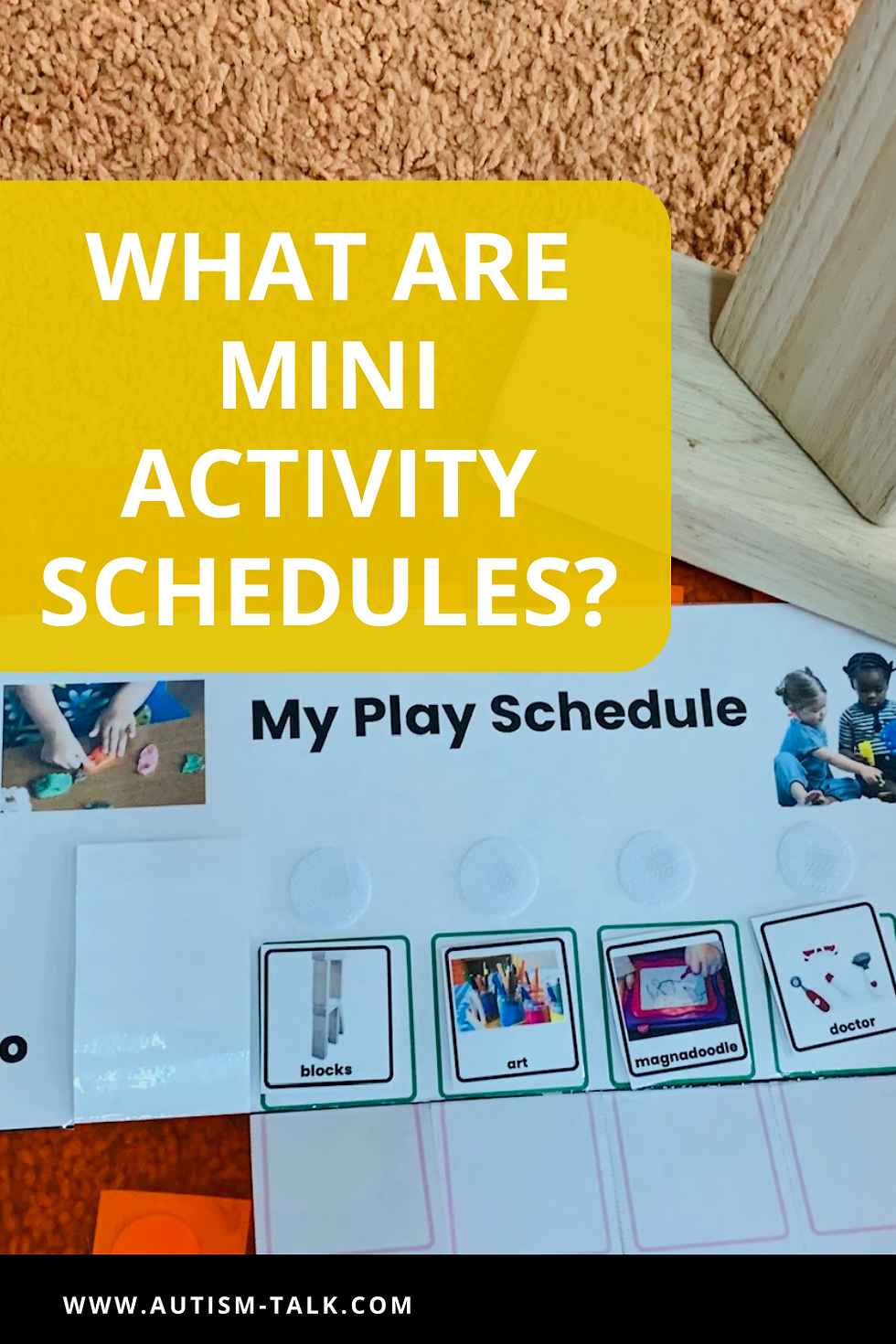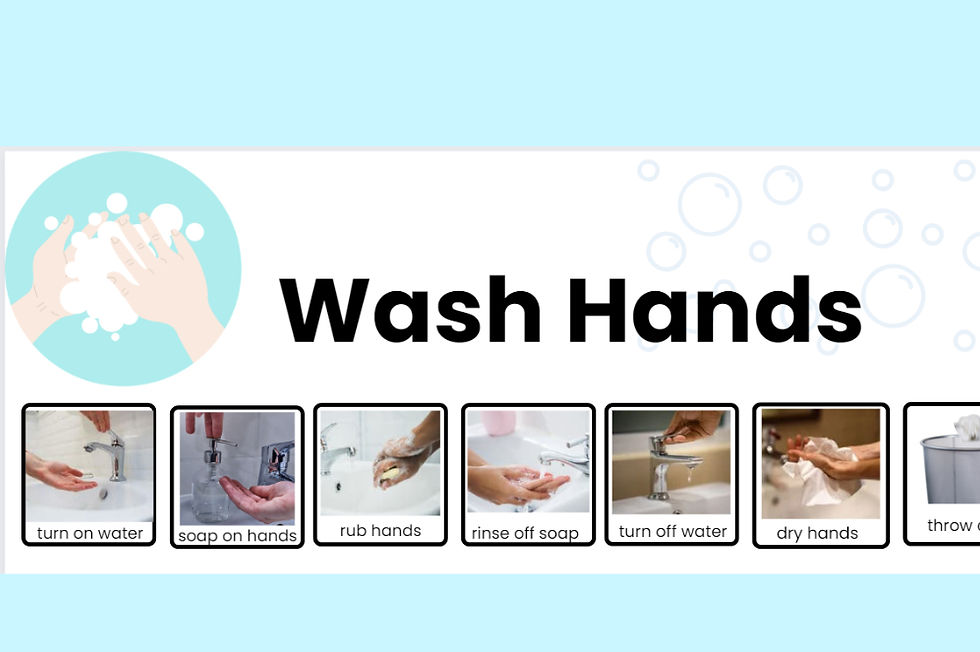Step-by-Step: Using Mini Activity Schedules to Support Autistic Learners
- Autism-Talk

- Nov 21, 2024
- 5 min read
Updated: Nov 29, 2024

Mini Activity Schedules: How They Can Help Your Autistic Child
If you’re familiar with visual schedules, you already know how helpful they can be for autistic children, but not as many people are familiar with min activity schedules.
These step-by-step visual tools focus on breaking down individual tasks or routines and are often a very effective tool to have if you are struggling with non-compliance, dependence on adult help, or rigidity in activities. Mini activity schedules can help build independence, reduce anxiety, and expand on play skills.
Table of Contents
What Is a Mini Activity Schedule?
A mini activity schedule is like a schedule within a schedule—a detailed, step-by-step visual guide for completing a single activity that is part of a larger routine.

For example, a child’s daily visual schedule might include “circle time.” When the child arrives at circle time, an aide could hand them a mini activity schedule that breaks the routine into smaller steps, such as:
hello song
weather
story
goodbye song

Similarly, at home, a child’s visual schedule might show “wash hands” as one of the steps in their after-school routine. To help them do this task independently, a mini activity schedule could be taped to the mirror above the sink, showing steps like:
Turn on the water.
One pump of soap.
Rub hands together.
Rinse hands.
Turn off the water.
Dry hands with a towel.
Put towel back.
By providing clear, visual instructions for each step, mini activity schedules help children understand what’s expected, stay focused, and complete tasks more independently. They are a practical, adaptable tool for breaking down routines into manageable chunks, making activities feel less overwhelming and more achievable.
How Mini Activity Schedules Can Help

Mini activity schedules offer many benefits. They can:
Build Independence: By giving step-by-step instructions, mini activity schedules reduce the need for verbal prompts from adults. Over time, many children are able to complete activities on their own.
Reduce Anxiety: Knowing what to expect can help a child feel less overwhelmed, especially in new or challenging situations.
Develop Play Skills: A schedule for dollhouse play or a mini activity schedule for "free play" for example, can encourage a child to gradually engage in more play activities or guide a child to engage in more complex play within the dollhouse.
Decrease Resistance to New Activities: Tasks like trying out a new playground or going
to the dentist can feel less daunting when broken into simple, visual steps. You can begin with 1 or 2 steps and gradually add steps before a child gets to do a more preferred activity. For instance, at table time, initially child has to complete 2 steps of table time mini activity schedule and then gets a time in the motor room and gradually steps are added.
Encourage Flexibility: While mini schedules are structured, they can also introduce small changes gradually, helping children learn to adapt to new steps or routines. Many children with autism will play very rigidly, for instance every recess pouring sand out filling bucket and repeating. This activity can be expanded gradually so eventually they go down the slide, play tag, swing, and then go to the sand box.
Practical Examples of Mini Activity Schedules
Teaching Play with a Dollhouse
A mini activity schedule for dollhouse play might include the following steps:
Set up dollhouse.
Dad cooks.
Family eats.
Family goes to bed.
Clean up dollhouse.
As the child becomes more familiar with the pictures and using the mini schedule, new steps can be gradually added to expand play such as go to playground, ride in car, work on computer, or take bath.
Grocery Store Shopping
A grocery store can be an overwhelming environment for autistic children. A mini activity schedule can be helpful to reduce anxiety or decrease behaviors that make shopping difficult such as running through the aisles. It might look like this:
Pick a cart or basket.
Find bananas (or another specific item on the list).
Place the item in the cart.
Wait in line.
Help place items on the counter.
Go to car.
Treat
This sequence can make the trip feel predictable and manageable and gently reminds the child that a treat is coming soon. Over time, the child might take on additional responsibilities, such as checking off items on a simple list or finding items independently.

Playing on the Playground
New or busy playgrounds can be intimidating, but a mini activity schedule can help ease a child into the experience and increase flexibility. For example:
Ladder
Slide
Swing
Sandbox
Gradually, the child might explore new areas of the playground or play with peers without needing the schedule.
Activities That Might Benefit from a Mini Activity Schedule
Here are just a few examples of activities where mini activity schedules can be helpful:
Daily Routines: Brushing teeth (click here for a free mini activity schedule for tooth brushing), getting dressed, washing hands, putting on shoes
School Activities: Circle time, group games, art projects, independent workstations
Play: Dollhouse, blocks, pretend play, playground
Infrequent Events: Visiting the doctor, grocery shopping, attending a birthday party
How to Make a Mini Activity Schedule
One of the best things about mini activity schedules is that they don’t have to be fancy or expensive. Here are some easy, low-prep ways to create one:
Post-It Notes: Draw or write each step on a Post-It note. Stick them on a wall or table and remove each one as it’s completed.
Dry Erase Board: Draw the steps on a small dry erase board. Erase each step as your child finishes it.
Printed Pictures: Print pictures of the steps involved in the activity, put in a notebook or on a ring.
Digital Options: Use a tablet or smartphone to show pictures or videos of each step. Apps like Choiceworks or First Then Visual Schedule are great for creating schedules on the go.
Magnetic Boards: Create magnetic icons for each step and place them on a magnetic board or fridge, rearranging as needed.
Flipbooks: Use a small photo album and place a photo or an index card with a picture drawn on it to make a flipbook with one step per page.
These quick, flexible options mean you can create a mini activity schedule on the fly, whether you’re at home, in the classroom, or out in the community.
Common Concerns
Some parents and teachers worry that using a mini activity schedule might feel impractical or overly rigid. For example, they might ask, “Will my child need a schedule for snack time forever?”
In my experience, most children adapt quickly and transition away from the schedule once they’ve gained the skills and confidence to perform the activity independently. Mini activity schedules are tools to build independence—not a permanent crutch.
Why They’re Worth Trying
Mini activity schedules are a bit of effort initially, but they can be really beneficial if you have a child that is stuck, whether it is from anxiety, lack of skills, or for some reason that it is hard understand. They can encourage independence, reduce stress, and expand play skills. With time and practice, these schedules become a natural part of the learning process—and eventually, they are not needed at all.
%20(21).png)





Comments